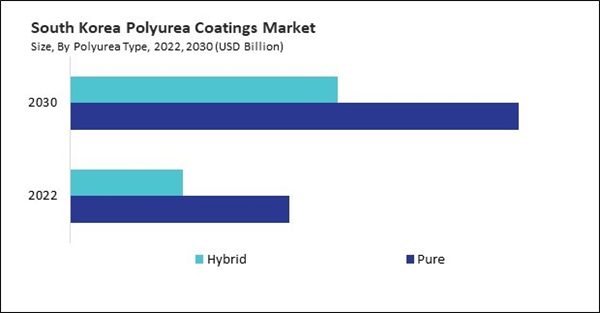Aliphatic isocyanate, a fundamental raw material in polyurea coatings, is derived from aliphatic diisocyanates, such as hexamethylene diisocyanate (HDI) or isophorone diisocyanate (IPDI). This critical component significantly influences the performance and characteristics of polyurea formulations. Aliphatic isocyanates offer distinct advantages, particularly in applications where UV stability and color retention are paramount. Thus, China utilized 305.98 tonnes of these coatings in 2022.
The China market dominated the Asia Pacific Market by Country in 2022, and would continue to be a dominant market till 2030; thereby, achieving a market value of $214.7 Million by 2030. The India market is registering a CAGR of 8.7% during (2023 - 2030). Additionally, The Japan market would showcase a CAGR of 7.2% during (2023 - 2030).
The ability of coatings to conform to complex shapes, resist abrasion, and provide a seamless protective layer makes them ideal for applications such as tank linings, containment systems, and equipment protection in chemical and oil industries. Polyurea's unique formulation makes it highly flexible, enabling it to conform to the complex shapes and contours of tanks. This flexibility ensures the coating adheres closely to the substrate, covering every nook and cranny.
Furthermore, customization and a broad range of color options have become significant trends in the market. End-users seek coatings that provide protection and contribute to the aesthetic appeal of surfaces. In response, manufacturers are providing an extensive range of color options and customization choices to accommodate a variety of preferences.
As per the data released in 2023 by the State Council of China, the country's freight volume expanded 7.1 percent year on year to 4.74 billion tonnes in July, with the pace of increase accelerating from a rise of 4.3 percent in June. Furthermore, As per the India Brand Equity Foundation, in conjunction with the initiative 'Make in India' and the production-linked incentives (PLI) scheme, the government has implemented the National Infrastructure Pipeline (NIP) to stimulate the expansion of the infrastructure sector. These initiatives have rendered the "Smart Cities Mission" and "Housing for All" programs more effective. Therefore, the rising infrastructure development and transportation sector in Asia Pacific is expected to boost the demand for these coatings in the region.
Based on End User, the market is segmented into Building & Construction, Transportation, Industrial, and Others. Based on Polyurea Type, the market is segmented into Pure, and Hybrid. Based on Raw Material, the market is segmented into Aliphatic Isocyanate, and Aromatic Isocyanate. Based on Technology, the market is segmented into Spraying, Pouring, and Hand Mixing. Based on countries, the market is segmented into China, Japan, India, South Korea, Singapore, Malaysia, and Rest of Asia Pacific.
List of Key Companies Profiled
- Pearl Polyurethane Systems LLC
- American Polymers Corp.(Polycoat Products)
- Teknos Group Oy
- PPG Industries, Inc.
- Rhino Linings Corporation
- BASF SE
- Huntsman Corporation
- Covestro AG
- Sika AG
- Sherwin Williams Company
Market Report Segmentation
By End User (Volume, Hundred Tonnes, USD Billion, 2019-2030)- Building & Construction
- Transportation
- Industrial
- Others
- Pure
- Hybrid
- Aliphatic Isocyanate
- Aromatic Isocyanate
- Spraying
- Pouring
- Hand Mixing
- China
- Japan
- India
- South Korea
- Singapore
- Malaysia
- Rest of Asia Pacific
Table of Contents
Companies Mentioned
- Pearl Polyurethane Systems LLC
- American Polymers Corp.(Polycoat Products)
- Teknos Group Oy
- PPG Industries, Inc.
- Rhino Linings Corporation
- BASF SE
- Huntsman Corporation
- Covestro AG
- Sika AG
- Sherwin Williams Company
Methodology

LOADING...









